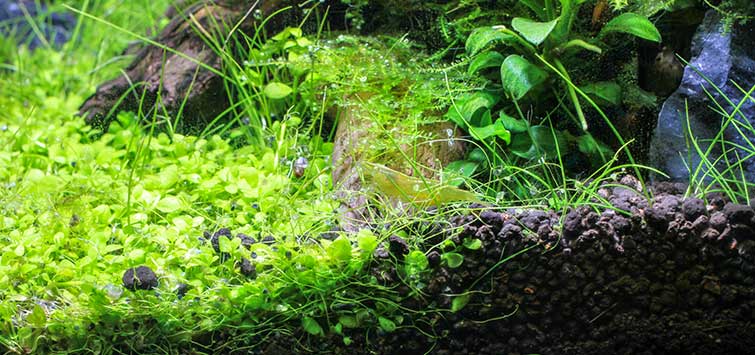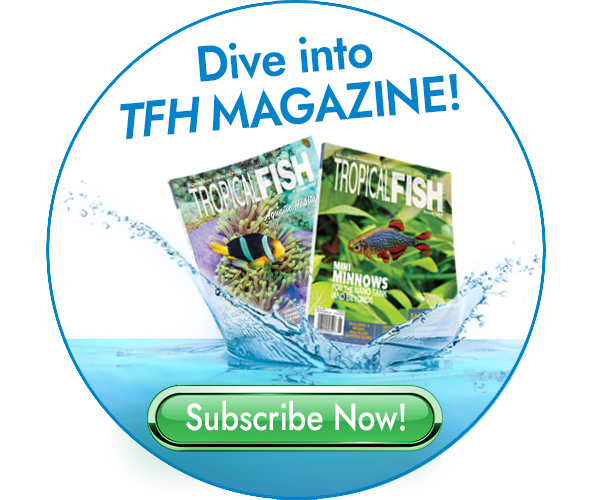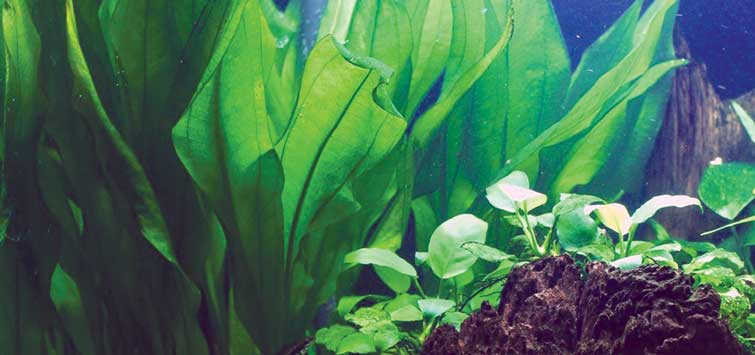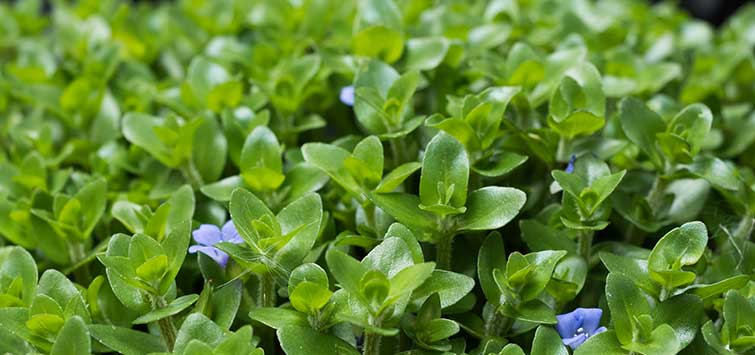Mastering Substrate in the Nature Aquarium
Author: Takashi Amano
The aquatic plant layout master explains the key role of substrate composition in the long-term maintenance of the planted aquascape.
Growing aquatic plants in an aquarium over a long period of time is one of the basic principles of the Nature Aquarium. This is also called long-term aquascape maintenance. Long-term aquascape maintenance is the basis of the Nature Aquarium aesthetic, since aquatic plants not only grow more densely and become more beautiful, but also appear more natural with the passage of time. I had many trials and errors until I established the layout method of Nature Aquarium, and the part that required the most effort was the substrate.
Feeding Rooted Plants
The first thing I focused on in order to grow healthy aquatic plants was the function of a root, as many plants absorb the nutrients necessary to grow through their roots. Although some aquatic plants that are well adapted to life under water absorb nutrients directly through the surface of their leaves (such as Riccia and stem plants), quite a few aquatic plants—such as Cryptocoryne, Echinodorus, hair grass, Glossostigma, and cobra grass—absorb nutrients vigorously through their roots.
Since these plants are often used to create a layout in the Nature Aquarium style, the substrate must contain a sufficient amount of nutrients. It is also well known that microorganisms in soil play an important role in plants taking up nutrients though their roots. So I contemplated on how to store nutrients and grow microorganisms in the substrate.
Choosing Gravel and Soil
Natural soil contains organic matter from decayed plants and fallen leaves, which decompose with the help of soil microbes and turn into inorganic nutrients that plants can absorb. If this natural mechanism can be recreated in an aquarium, aquatic plants should grow well. However, organic matter that is simply placed beneath the gravel becomes putrid due to the lack of oxygen, and that affects the water quality adversely. The pores in fine gravel become clogged due to water pressure and become impermeable. When I mixed organic nutrients with coarse-grain pumice with many indentations on the surface and placed them under the gravel, aquatic plants started growing well. Pumice keeps the pores in the substrate from clogging, and aerobic microorganisms that decompose organic matter can function well. I use this as the substrate base.
I used to use coarse marine sand as the substrate material over this base, but I was looking for a way to improve this method, since some plants did not grow well due to the hardness of the water increasing from the sand. Again I sought for the solution in natural soil. Natural soil contains various organic and inorganic components that help plants grow. Plants grow well especially in black soil that is rich in organic acids such as humic acid and trace elements such as iron. Natural soil is generally acidic and has the ability to adsorb calcium ions, thus turning water slightly acidic and soft and making it suitable for growing aquatic plants.
However, soil added directly to an aquarium turns muddy and clouds up the water, and the substrate becomes impermeable. Therefore I processed the natural soil into particles so that it may be used as a substrate material. It improved the growth of almost all aquatic plants dramatically and reduced the incidences of aquatic plants failing to grow. Cryptocoryne and Echinodorus, which tend to spread roots in the substrate, and those that grow by runners, such as hair grass, Glossostigma, and cobra grass, grow especially well in this substrate, since their roots grow quickly. Slightly acidic and soft water is well suited for growing practically any of the stem plants, and so my combination of substrate materials became the foundation of the substrate in the Nature Aquarium.
Determining the Right Soil Grain Size
I use various-sized aquariums in making my Nature Aquarium layouts, from very small to very large, and there are many different types of aquatic plants from small to large. Although standard-size soil works fine when planting large aquatic plants in a large aquarium, the grain of the standard soil is sometimes too large for planting small aquatic plants in a small aquarium, and the plants in such a setup do not always grow well. European clover (Marsilea sp.) and pearl grass “Cuba” (Hemianthus callitrichoides) in particular have this tendency, so I use a thin layer of fine powder-type soil over the regular substrate when planting these kinds of plants.
In a small aquarium I can use the powder-type soil by itself, but I avoid using the powder variety alone in larger tanks to keep the pores from clogging with water pressure. So in an aquarium larger than 60 cm, I use the standard-size soil and place the powder-type soil over it. If aquatic plants come loose and float up right after planting even with the powder-type soil, I plant them again and sprinkle some more of this soil over the plants to settle them into place. The powder-type soil is suitable for this type of use, since it is fine enough to fall through leaves and get between roots.
Cosmetic Sand
I sometimes use cosmetic sand in the foreground to create some variation in the substrate design. I have discussed the specific method to split the substrate for this in a previous article (“Substrate in the Nature Aquarium,” TFH July 2005). Very fine sand is not suitable for the purpose of long-term aquascape maintenance, but rather cosmetic sand, with a somewhat larger grain, works well, hiding the dirt and allowing the water to permeate. While very fine, pure white sand will work for a short time, the pores collapse and the sand turns dark-colored and anaerobic gradually over a long period of time, even when it is laid very sparingly. For maintaining an aquascape over a long period of time in a very large aquarium, coarse sand should work well as cosmetic sand.
DATA
Aquarium: W60 x D30 x H36 (cm)
Lighting: NA lamp 20W x 4
Filter: Super Jet Filter ES-600
Substrate: Aqua Soil, Power Sand Special S, Bacter 100, Clear Super, Tourmaline BC, Penac W/for Aquarium, Penac P
CO2: Pollen Glass, 3 bubbles per second via CO2 Glass Counter (using Tower/20)
Aeration: Lily Pipe P-2
Additives: Brighty K; Green Brighty STEP2; ECA
Water change: 1/3 once a week
Water quality: Temperature 26ºC, pH 6.8, TH 20 mg/l
Aquatic plants: Eleocharis acicularis, Hemianthus callitrichoides
Aquatic animals: Hemigrammus rodwayi, Crossocheilus siamensis, Otocinclus sp., Caridina japonica
[Note: The hardware itemized above represents the author’s specific choices; equivalent results may be obtained with other equipment and accessories—Eds.]
DATA
Aquarium: W120 x D45 x H60 (cm)
Lighting: NAG-150W Green x 2 (Solar)
Filter: Super Jet Filter ES-1200
Substrate: Aqua Soil, Power Sand Special L, Bacter 100, Clear Super, Tourmaline BC, Penac W/for Aquarium, Penac P
CO2: Pollen Glass Beetle 50, 3 bubbles per second via CO2 Beetle Counter (using Tower/20)
Aeration: Lily Pipe P-4
Additives: Brighty K; Green Brighty STEP2
Water change: 1/3 once a week
Water quality: Temperature 24ºC, pH 6.6, TH 20 mg/l
Aquatic plants: Cryptocoryne sp. “tall form green,” Cryptocoryne retrospiralis, Cryptocoryne beckettii, Cryptocoryne wendtii “green,” Cryptocoryne walker
Aquatic animals: Trigonostigma heteromorpha, Crossocheilus siamensis, Otocinclus sp., Caridina japonica
[Note: The hardware itemized above represents the author’s specific choices; equivalent results may be obtained with other equipment and accessories—Eds.]

.png?h=595&iar=0&w=2781&hash=5FD5E69473BCC22199FBFA2FB71B6033)



